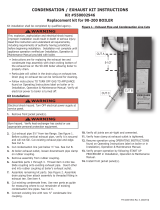
17
B. Design Requirements Unique to Horizontal Twin Pipe Venting Systems
Table 7.5 summarizes all horizontal twin pipe vent options. Illustrations of horizontal twin pipe vent systems are shown in
Figures7.7–7.9.InadditiontotherequirementsinPartVII-A,observethefollowingdesignrequirements:
1. Permitted Terminals for Horizontal Venting:
Terminal Option A: Fittings–Ventterminatesinaplainend.IntaketerminatesinaPVC90sweepelbowpointingdown.
Outer edge of both terminals must be within 10” of the wall surface (Figure 7.7).
Use of rodent screens (not supplied) is generally recommended for both terminations. These can be fabricated from 2 x 2
(1/2” mesh) stainless steel screen. They are installed as shown in Figure 7.18.
Ifnecessarytoachieverequiredclearanceabovegrade,CPVCorCPVC/PVCventsystemsmaybeterminatedusingttings
on snorkels as shown in Figure 7.6. When this is done, the equivalent length of all pipe on the exterior of the building, except
fortheterminalttingsthemselves,mustbecountedwhencalculatingtheequivalentlength.Themaximumverticalrunofthe
snorkel is 7 feet. Brace both the vent and inlet piping if required.
TerminalOptionB:IpexLowProleTerminal–ThisterminalisshowninFigure7.8.Iftheterminalisorientedvertically
(alternate orientation shown in Fig 7.8) the exhaust opening must be on the top as shown. See Part VII-E of this manual and
the Ipex instructions provided with the terminal, for installation details.
TerminalOptionC:Diversitech“LowProle”Terminal–ThisterminalisshowninFigure7.8.Iftheterminalisoriented
vertically (alternate orientation shown in Fig 7.8) the exhaust opening must be on the top as shown. See Part VII-E of this
manual and the Diversitech instructions provided with the terminal, for installation details.
Terminal Option D: Ipex FGV Concentric Terminal - This terminal is shown in Figure 7.9 and may be used with CPVC/PVC
vent systems. This terminal is available in various lengths and in both PVC and CPVC. Terminals acceptable for use with
these vent options are as follows:
Ipex PN FGV Concentric Terminal Description
196005 2 x 16” PVC
196105 2 x 28” PVC
196125 2 x 40” PVC
196006 3 x 20” PVC
196106 3 x 32” PVC
196116 3 x 44” PVC
197107 3 x 32” CPVC
197117 3 x 44” CPVC
See Part VII-E of this manual and the Ipex instructions provided with the terminal, for installation details.
Terminal Option E: Diversitech Concentric Terminal - This terminal is shown in Figure 7.9 and may be used with CPVC/
PVC vent systems. See Part VII-E of this manual and the Diversitech instructions provided with the terminal, for installation
details.
2. Horizontal Vent and Air Intake Terminal Location - Observe the following limitations on the vent terminal location (also see
Figure 7.10). When locating a concentric terminal, observe the limitations outlined below for “vent terminals”.
• Vent terminal must be at least 1 foot from any door, window, or gravity inlet into the building.
• WhenTerminalOptionA(ttings)areused,maintainthecorrectclearanceandorientationbetweentheintakeand
exhaust terminals. The recommended horizontal spacing between inlet and exhaust terminals is 36”, however this
spacing may be reduced to 12” (center-to-center) if necessary. The elevation of the exhaust terminal must be at,
or above, that of the intake terminal. The 12” minimum horizontal spacing must be maintained regardless of the
vertical separation between the intake and exhaust terminals. Both terminals must be located on the same wall.
• The bottom of all terminals must be at least 12” above the normal snow line. In no case should they be less than 12”
above grade level.
• The bottom of the vent terminal must be at least 7 feet above a public walkway.
• Do not install the vent terminal directly over windows or doors.
• The bottom of the vent terminal must be at least 3 feet above any forced air inlet located within 10 feet.
• USA Only: A clearance of at least 4 feet horizontally must be maintained between the vent terminal and gas meters,
electric meters, regulators, and relief equipment. Do not install vent terminal over this equipment. In Canada, refer
to B149.1 Installation Code for clearance to meters, regulators and relief equipment.
• Do not locate the vent terminal under decks or similar structures.
• Topofterminalmustbeatleast24”belowventilatedeves,softsandotheroverhangs.Innocasemaytheoverhang
depth exceed 48”. Where permitted by the authority having jurisdiction and local experience, the terminal may be
located closer to unventilatedsofts.Theminimumverticalseparationdependsuponthedepthofthesoft.See
Figure 7.10 for details.
• Vent terminal must be at least 6 feet from an inside corner.





















